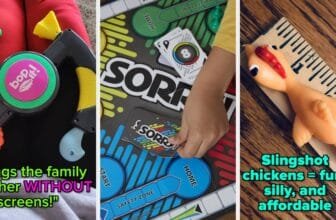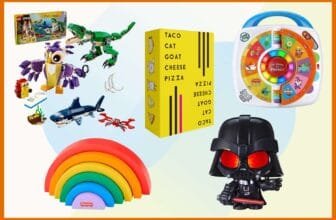
Crawling seems like an easy skill initially because all we have to do is get our kids on the floor then poke them with toys until they figure it out – right? Not quite!
For many parents, the crawling stage seems to last forever. Some kids seem to take longer than others, but at some point, they all crawl. You can also make so many mistakes when teaching your baby to crawl, and you can end up causing some serious setbacks.
We know you want to capture your baby’s first movements in your heart (and on video) for the longest time, so let’s dive right in!
What Month Does a Baby Start Crawling?
Typically, babies start crawling around the 9th month. Some can start crawling from as early as the 6th month, while others wait till the 10th month. While most infants crawl and cruise before walking, some skip the crawling phase and go straight to sitting up, standing, and walking.
6 Types of Crawling Styles
Did you know that there are several different styles of crawling? We’ll explain the different types of crawling and how they can affect your baby’s growth.
When your little one does not move in one of these ways, it doesn’t mean anything unusual or wrong is happening! And because your baby exhibits one of these movements does not mean that they will be crawling “normally.” After all, no two babies are the same.
1. Toe Crawling
The first type of crawling that most babies master is toe crawling. This kind of movement happens when your baby gets to the point where he pushes with his toes and scoots along using his palms for balance.
While this might be cute, it can also be a very dangerous habit. You see, in order to keep his balance and not fall over, your baby needs to turn his feet inward. This can lead to muscle imbalances and tightness in the hips that will take time to correct, so make sure you don’t encourage this kind of movement too much! But on the plus side, most babies stop toe crawling after just a few months.
2. Rolling Crawl
The rolling crawl is a very advanced form of movement. In this kind of crawling, your baby will roll over onto his belly then push with his arms and legs to move from one place to another. Because babies can only rely on their upper body strength for so long, it’s not uncommon for them to give up and start on their hands and knees shortly after starting the rolling crawl.
3. The Hook
This form of movement should not be encouraged because it puts your baby in a dangerous position. In this rolling fashion, your baby will curl their pinky finger over his or her thumb with both arms just under their hips. This is not a safe way to crawl because it’s easy for your baby to slip out and fall on his head or back.
4. The Hoover
The Hoover crawl (also known as the bear crawl) works very similarly to the rolling crawl but with one major difference. Your baby will fall onto his or her belly and use his or her arm to push off the ground instead of pushing with both arms. With this kind of movement, your baby’s legs are out straight in front of him, which is not a safe position for crawling.
5. Overhand Crawl
The overhand crawl is a very common type of movement that most babies can master by 12 months. Unlike all the other kinds of crawling, in order to move with this technique, your baby needs to bend his or her arms and hold them at a 90-degree angle under his or her chest. This is why it’s also referred to as an overhand crawl or sometimes even a bar crawl!
How to Encourage Your Baby to Crawl – The Do’s and Don’ts
If your baby is not yet crawling, you might be wondering how to help him or her start learning how to crawl. The truth is that there are several things you can do to encourage him or her to crawl more and even move faster!
Dress Your Baby in Clothes That Are Easy To Move Around In
There’s no point trying to get them crawling if they can’t even fit enough of their body through the outfit! Clothes like jeans and pants with elastic waistbands can be hard for babies to move around in and often cause them to either get stuck or fall down a lot. Try dressing your baby in soft cotton pants, shorts, leggings, or even shirts that are easy for him to move his arms around in.
Give Your Baby Plenty of Time to Play on the Floor Each Day
As mentioned earlier, crawling is a very important developmental milestone that all babies eventually will reach some point. The problem is that many babies don’t give crawling enough time and end up falling behind on other important milestones like sitting or walking because they are too busy trying to master crawling!
This is the reason why you should make sure your baby gets plenty of floor time each day. Each child has different needs regarding how much floor time they need every day, but our advice would be to try and schedule in 1-2 hours per day if possible. Maybe even split this into two sessions if you have more than one child so that each can get their share of floor time!
Remove Dangerous Objects in Your Baby’s Path
Just because he is crawling doesn’t mean you can drop everything and forget about safety! Make sure there are no small objects, loose or sharp pieces of furniture in his play area.
You also don’t want to put him on any surfaces that could be dangerous either (like a wood floor with large gaps). It’s essential to make sure the area is completely safe so you know he won’t get hurt if he falls or moves too fast while crawling.
Never Force Your Baby to Crawl If They Don’t Want
Many babies will try out different types of movements before moving on to crawling. Forcing them into a new position when they’re not comfortable with it can slow down their progress or even make them regress in skill level!
If you notice your baby likes to pull up and stand next to things more than crawling, don’t pressure him or her into moving on just because the other kids are already doing it. Remember, he or she will get there eventually if you give him or her enough floor time each day!
Tell the Caregivers about Your Baby’s New Crawling
It’s also essential that everyone knows how to care for a baby once he starts learning new movements (like putting bumpers on stairs). Many people are surprised to see their baby suddenly start moving right before they head off into the first year of life and may not know how to react when they do move!
Make sure everyone is on board and ready for your baby to start crawling (in case he gets up during daycare, or you’re visiting someone who isn’t aware of all his skills).
When Your Baby Starts Trying To Move, Don’t Hurry Him Along
If you think your little one has just started showing signs of being interested in crawling, don’t jump in right away and try to get him moving as fast as possible! You can ruin his chances of ever wanting to move by pushing him too hard.
All babies are different and crawl when they’re ready, but this doesn’t mean you should automatically push every baby to get moving as soon as possible. If your baby wants to start crawling, he will do so on his terms – it’s best to leave him be until he starts showing signs of wanting to move around.
Tips for Keeping Your Crawling Baby Safe
When your baby starts learning how to crawl, it’s essential to keep him safe by ensuring the area is baby-proof. You don’t want him to hurt himself if he falls on something sharp or tumbles over one of your toys you’ve forgotten about (or a few other reasons why you should have a baby-proofed house).
Here are some tips for keeping your crawling baby safe:
Remove Sharp Objects from the Crawling Space
Cover all sharp and breakable objects in the room before giving your baby access to that space. When babies start learning how to crawl, they’re still pretty wobbly. They could easily fall or roll onto any number of items around their space which can cause serious injury.
If you notice areas around your home with sharp open objects like broken glass, knives, or scissors, tip-toe over to that area and make sure your crawling baby won’t have access to these objects. It’s also a good idea to keep breakable items like lamps or other household goods out of reach, so you don’t need to worry about them suddenly getting knocked over onto your little one.
Use Safety Gates in Your Staircases
Consider putting safety gates at the top and bottom of staircases in case your baby tries to crawl up or down any stairs before they’re learning how to walk. If you have stairs in your home, you should put safety gates on either end so the baby can’t climb up (or down) the stairs before he learns how to walk. You may not be able to keep him from trying, but at least you’ll stop any severe accidents before they can happen.
Double-Check the Playing Area
When your baby starts moving around the house, make sure he has somewhere safe to play. This is important if you have more than one small child in the house because it will be almost impossible for anyone to watch them all the time.
Getting a playpen (or several) so your crawling baby has somewhere safe to play while you take care of other things can do wonders. You don’t need anything too fancy, and something like this one should work great until your little one develops his skills further.
Bottom Line
The time it takes for a baby to learn the art of crawling can vary a lot from child to child and even family to family. Some babies are just late bloomers. Some children are stubborn and dragging their feet; other little ones seem eager and ready as soon as they hit the ground.
To keep your little one safe while he learns new skills like these, make sure you have a baby-proofed home with safety gates in any places where there are stairs (or other hazards). If you want help planning out the rest of his development so that he grows up as healthy as possible, contact us today. We’re here to provide guidance and assistance throughout every stage of life.
Sources: Centers for Disease Control and Prevention (CDC), Important Milestones: Your Baby By Nine Months, May 2024, Office on Women’s Health (OASH), Making Your Home Safe For Baby, October 2018, National Center for Biotechnology Information (NCBI), Developmental Continuity? Crawling, Cruising, and Walking, March 2012, and U.S. Consumer Product Safety Commission (CPSC), Childproofing Your Home- 12 Safety Devices to Protect Your Children.






